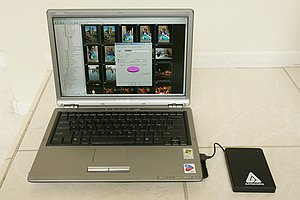Digital Workflow: organizing and backing up images while on the road.
Establishing a system, or workflow while you are on assignment is essential. There’s nothing worse than returning from a trip and being faced with a huge editing job. Good workflow while on assignment also helps you stay on top of the “story”.
I shoot all day, then return to my hotel and fire up my Vaio VGN-S260 laptop. The first order of business is to download the CF cards to my laptop using the Cardbus 32 PC slot adapter. The Cardbus 32 save me lots of time as compared to USB downloads using a card reader or the cable connected to the camera.

Once the images are downloaded to the laptop, I open Breezebrowser to view and organize them. At the begetting of each assignment I create folders for each country I am working in, and under the country folders I create sub folders for each day. Each Day’s images go into the corresponding days’ folder.

Since I use two cameras, (which have the date and time synchronized) I dump all the photos into that days folder and let Breezebrowser sort them by “timestamp”. Since not all images are keepers, I go through each one and immediately delete any images that are out of focus, compositionally bad or in which subjects have their eyes closed or whatever.
Once this initial edit is done, I batch rename the photos using Breezebrowser’s batch rename feature. Typically I batch rename using the clients name followed by the country name followed by a number. For example WorldVision_Cambodia_001.jpg.
After the days images have been downloaded to my computer and renamed, I hook up my Apricorn EZBus Mini external hard drive and copy the folder over. When copying is finished I check to see that the files exist on my laptop and on the EZBus Mini. Once that is confirmed I reformat my CF cards using the “reformat” process in my Canon Mark II.

Finally, and perhaps most importantly I place my Vaio laptop and the EZ Bus Mini in different bags so that if one gets stolen or lost I still have a copy of all my hard-earned images.









Hi Karl,
I’d be interested in a short answer to these two questions:
1. Still happy with the Nikon solution? I’ve shot Nikon since 1978 and now have a D700. I still have a use every Nikon I ever bought FM2, FE2, F4s, D300(sold it), D700.
2. As you obviously are a post processing minimalist, like me, what editing software for your pics do you use if more post is required than that provided by Breezebrowser.
I’m a fan of “get it right in the camera in the first place. If you are running any workshops in 2011, I’d be keen to come along. I’m in Sydney but also travel a lot.
Steve
Hi Stephen,
Thanks for the comment and questions…
1. Still happy with the Nikon solution? Yes, I am loving the new Nikons!
2. As you obviously are a post processing minimalist, like me, what editing software for your pics do you use if more post is required than that provided by Breezebrowser? I use an old copy of Photoshop 7 and never thought I needed to upgrade….it works fine for what I need to do.
Running any workshops in 2011? Yes, the Angkor Photo Workshop in July of this year, check it out using the drop-down menu on my blog.
Thanks again for the questions and I hope to see you on a workshop soon.
Karl
I’ll keep an eye on the website and try to get to the workshop in July.
Hey Karl,
Love your work!! I have a question: How often do you use Photoshop and what changes do you normaly make??
Keep up the GREAT work!!!! James, IL
Hi James,
I shoot jpeg and I have a very old copy of Photoshop 7. I don’t do much of anything with Photoshop other than an occasional bit of dodging and burning if necessary. What I post is straight of the the camera (obviously sized and sharpened for the web). When I deliver images to a client (NGO work) I do no “Photoshopping” at all. I never remove, clone, add, subtract or manipulate images. As a Photojournalist, it’s important that I avoid doing any of those things. I am not saying that shooting jpeg vs raw is better, or that Photoshop is “bad”, I just try to get things “right” in the camera and find that in doing so, I can provide clients with the images they need while spending little or no time in “post production”. Thanks for your question. Karl